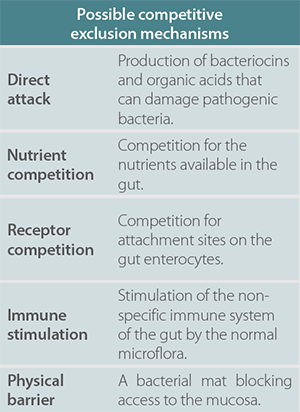Blog | Reading Time 2 minutes
Competitive Exclusion: an established concept with promising applications in poultry
Competitive exclusion: the phenomenon whereby normal healthy intestinal bacteria colonize the intestine and prevent colonization by transient pathogenic bacteria.
In the 1950s and 60s, with the intensification of chicken rearing, the issue of Salmonella contamination in meat emerged. Researchers started to look at preventative approaches. It was clear that as chickens grow older they become more resilient to Salmonella gut colonization. This led to the thought that maturation of the gut could prevent Salmonella from colonizing the guts of older birds. The role of the gut microbiota was soon identified as a key element of this resistance.
The birth of a concept
In nature, young chicks acquire their gut microbiota directly from the environment and mother hens. In intensive rearing conditions, as the eggs are hatched in near sterile conditions in incubators, the development of normal gut microbiota could be impaired or at least significantly delayed. A partially developed microflora could leave more room for undesirable bacteria, such as Salmonella, to colonize the gut. This is what led to the competitive exclusion (CE) concept. Initially, researchers fed diluted gut contents of mature, free-range hens to intensively reared chicks, which resulted in increased resistance to Salmonella contamination. The Finnish microbiologist Professor Nurmi defined this concept in Nature in 1973. In 1974, Rantala further showed that the birds’ protection was linked to the administration of viable anaerobic bacteria. Competitive Exclusion was born.
A great tool against enteropathogens

Since then, the science behind the concept and its applications have evolved. Today, we no longer use minced gut from adult chickens!
Commercial products have been developed based on the industrial propagation of healthy adult chicken gut microbiota under controlled conditions (e. g. AVIGUARD). If the concept was originally designed for Salmonella reduction in chicken, it is shown to be effective against other enteropathogens such as Escherichia coli, Clostridium perfringens, Listeria, or Campylobacter, and other avian species (e. g. turkeys, pheasants, and quails). The main mechanisms involved in CE have been described as: direct attack, nutrient competition, receptor competition, immune stimulation, and physical barrier (see table on the right).
Even though competitive exclusion is nearly 50 years old, it remains a promising concept for modern poultry production.
Published May 6, 2019 | Updated May 30, 2023
Related articles
Need specific information?
Talk to an expert